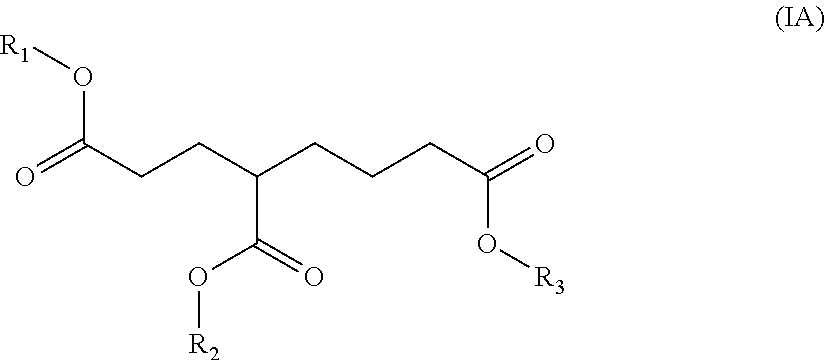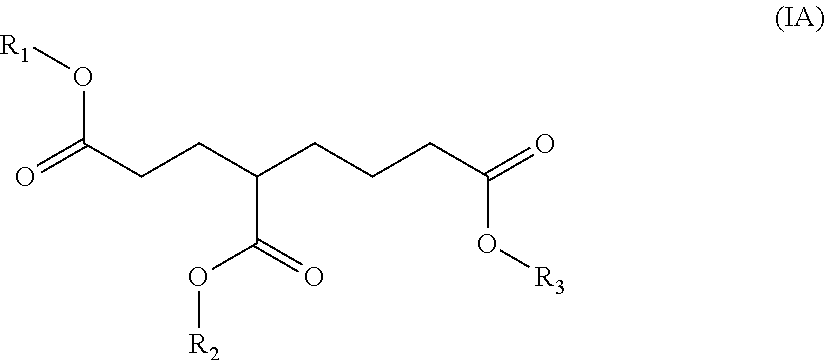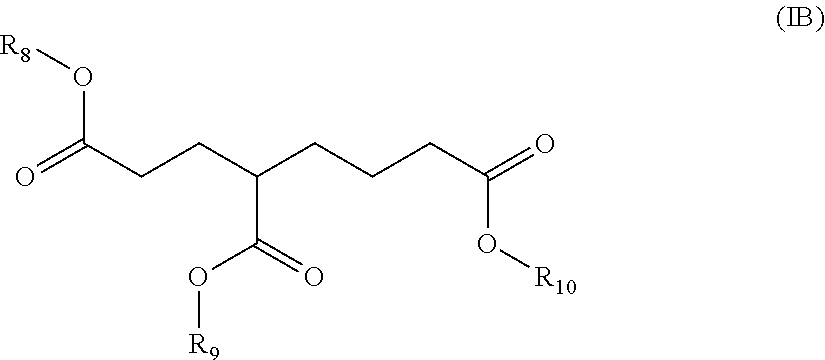Tri-carboxylic compounds as low-voc coalescing agents and plasticizing agents
a technology of tricarboxylic compounds and coalescing agents, which is applied in the direction of coatings, emulsion paints, etc., can solve the problems of high volatile organic content of coalescing agents, high voc, and undesirable use of coalescing agents, so as to maintain the flexibility of polymers, reduce the tg of coating water-based resin binders, and increase the number of carbons
- Summary
- Abstract
- Description
- Claims
- Application Information
AI Technical Summary
Benefits of technology
Problems solved by technology
Method used
Image
Examples
example 1
[0198]This example demonstrates that the HTCE-R1R2R3-based coalescing agent composition performs equally or superior to a conventional coalescing agent (Texanol™) in terms of coalescing properties, clarity and yet contributed very low-VOCs to the total VOC of the formulation. Example F-5 in Table 2 shows that the HTCE-RA was superior to Texanol™ in terms of a low temperature film that exhibits no cracking, which is indicative of a good minimum film forming temperature (MFFT) characteristic along with superior gloss. The film dry time indicative of surface tack was also at par which makes HTCE-RA a superior choice for this type of coating formulation.
TABLE 2Evaluation of 4 wt. % coalescing agent composition levels withRhoplex SG-30 (Tg = approximately 20° C)CONTROL(No coalescing agent)F-4F-5MaterialsRhoplex SG-30 (100%127.5 125.0125.0Acrylic Emulsion)DeeFo PI-4 concentrate 0.30.30.3(Defoamer)Deionized Water25.025.025.0Texanol ™—2.5—HTCE-RA——2.5Total formulation152.8 152.8152.8Weight ...
example 2
[0199]In this example, a 100% acrylic emulsion was chosen to demonstrate the effectiveness of the coalescing agent compositions of the invention. The results in Table 3 show that HTCE-RA (F-8) exhibited a similar performance to 100% VOC Texanol™ (F-7) with the exception of dry time or film tackiness. These deficiencies were improved with Example F-11, wherein a 50:50 wt. % blend of HTCE-RA / DXE-RB demonstrates that the coalescing agent compositions of the invention are able to address the inadequacies present in conventional coalescing agents and resulted in very low-VOCs coatings which were superior to coatings prepared from 100% VOC Texanol™.
TABLE 3Evaluation of 3.5 wt. % coalescing agent composition levels with Rhoplex AC-264.CONTROL(No coalescing agent)F-7F-8F-10F-11MaterialsRhoplex AC-264 (100%122.10100.00100.00100.00100.00Acrylic Emulsion)DeeFo PI-4 concentrate 0.240.240.240.240.24(Defoamer)Deionized Water 22.0020.0020.0020.0020.00Texanol ™—2.10———HTCE-RA——2.10——80:20 wt. % Ble...
example 3
[0200]In this example, a self-cross-linking binder / resin (Rhoplex HG-706)-based formulation is used. Rhoplex HG-706 is a 100% acrylic emulsion designed for interior and exterior VOC-compliant gloss and semi-gloss enamels, to produce high performance coatingsat 50 g / LVOC. By design, this binder does not require the presence of any low-VOC coalescing agent, but undesirably the binder does not perform at low temperatures. Table 4 demonstrates that HTCE-RA(F-2) endows the binder with excellent MFFT characteristics at 40° F. with superior gloss properties compared to Texanol™ (F-1) without undesirably enhancing any VOC characteristics (unlike Texan™).
TABLE 4Evaluation of 3.0 wt. % coalescing agentcomposition levels with Rhoplex HG-706.CONTROL(No coalescing agent)F-1F-2MaterialRhoplex HG-706101.35100.00100.00(Self-CrosslinkingAcrylic Emulsion)DeeFo PI-4 concentrate0.240.240.24(Defoamer)Deionized Water20.0020.0020.00Texanol ™—1.35—HTCE-RA——1.35Total formulation121.59121.59121.59Weight (g)V...
PUM
| Property | Measurement | Unit |
|---|---|---|
| temperatures | aaaaa | aaaaa |
| low-VOC coalescing composition | aaaaa | aaaaa |
| VOC coalescing | aaaaa | aaaaa |
Abstract
Description
Claims
Application Information
 Login to View More
Login to View More - R&D
- Intellectual Property
- Life Sciences
- Materials
- Tech Scout
- Unparalleled Data Quality
- Higher Quality Content
- 60% Fewer Hallucinations
Browse by: Latest US Patents, China's latest patents, Technical Efficacy Thesaurus, Application Domain, Technology Topic, Popular Technical Reports.
© 2025 PatSnap. All rights reserved.Legal|Privacy policy|Modern Slavery Act Transparency Statement|Sitemap|About US| Contact US: help@patsnap.com



